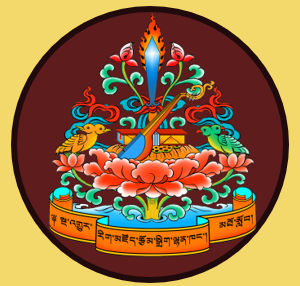
The ninth throne holder of the Palyul lineage, Drubwang Palchen Dupa, also known as Pema Kunzang Tenzin Norbu, was considered to be an incarnation of Panchen Vimalamitra. He was born in the Fire Female Pig year, 1887. He was recognized by the great Khenpo Ngawang Palzang as a direct incarnation of the second Dodrupchen, Kunzang Shenphen, and also as an emanation of Vajrapani, Gar Dongtsen, Gyalse Damzin Lhaje, Lhalung Palgyi Dorjee, Terchen Sangay Lingpa and Drubwang Pema Norbu. Moreover, Jamgon Rinpoche and others also confirmed him as the unmistaken incarnation of the second throne holder of the Palyul tradition, Drubwang Pema Norbu.
At the age of seven he was enthroned as the lineage holder of the Palyul tradition.
When he was nine years old, he had a vision of Guru Padmasambhava and received blessings from him. Thereafter he showed the signs of accomplishments.
He received ordination from Chokyi Nyima Rinpoche. Under his compassionate guidance, he studied and contemplated all the traditional practices of the Palyul lineage, including the teachings of the Great Perfection.
At an early age, he also received many teachings from great contemporary masters like Mipham Rinpoche, Kongtrul Yonten Gyatso, Palpung Khenpo Tashi Chopel, Mugsang Palbey Tulku Jigme Chokyi Lodro, Mugsang Khenpo Sherzang, Neygyab Pema Dondrup, Kathok Getse, Khenrab Woser and others. From them he received the oral transmissions and empowerments for countless important teachings. He studied myriad subjects, starting from basic spelling, grammar and poetics, up to the highest teachings of the Great Perfection. He relied upon them with great respect and clarified all his doubts about the teachings.
Then he went to Kathok Dorjeden. There he learned the great commentaries on the sutras and tantras from Khenpo Ngawang Palzang and Khenpo Kunpal.
He then received the bhikhshu vow from his root master, Khenpo Ngawang Palzang, and was given the name Thubten Chokyi Langpo. He also received all the pith instructions of the Heart Essence teachings; after practising with utmost diligence he realised the ultimate nature of the unity of awareness and emptiness, thereby inheriting the vidyadhara lineage of the forefathers.
When he was twenty, Chokyi Nyima Rinpoche passed away. He greatly regretted that he did not have the opportunity to receive the oral transmission of the canonical teachings of Lord Buddha (Kangyur) from him. But one night he dreamed of the master giving him the oral transmission. He then received the transmission in dreams over two continuous nights.
He took the responsibility for one of the major monasteries of the Palyul tradition in his early twenties. There he gave teachings on Namcho, the treasures of Ratna Lingpa, Kagye, Gongdu and others to many students. He also conferred his first Rinchen Terzod empowerments there. Before the empowerments, when he did the preliminary practice of Vajrasattva, he dreamed of Khenpo Gyaltsen Odzer giving him five conches arranged on a bell. This was a sign of being granted the permission to confer the empowerments.
He built many statues of buddhas, as well as monasteries, and composed many commentaries and gave many teachings. He gave the instructions on all the practices of the kama and terma teachings, and he also taught the unique traditions of Palyul like the construction of mandalas, making ritual cakes and the usage of the ritual objects and instruments.
In 1923, at the age of thirty-seven, he established a monastery as prophesied by Terton Sangag Lingpa and named it Shedrup Thosam Norbu’i Lhunpo (“The Jewel Mountain of Teaching, Practice, Listening and Analysing”). He provided accommodation for about fifty life-long practitioners. He invited Khenchen Ngagi Wangpo to the monastery and requested him to be the foremost abbot of the monastery. He then requested him to give teachings on the works of Longchen Rabjam and Mipham Rinpoche, along with other teachings. He provided the review instruction at that time. Later he succeeded Khenpo Ngagi Wangpo as the second abbot of the monastery and continued to teach and give empowerments.
He did not utilise the wealth he received from performing rituals for the dead and those who were ill for personal benefit; rather, he offered all of it as revenue for Dago Monastery for developing the monastery premises, building rooms for accommodations and other projects. He composed six great volumes of teachings corresponding to the six paramitas. Becoming a fully renounced practitioner, he wandered alone through the place called Odsal and the sacred place Kharchu Drak, and assiduously engaged in practice. He actually dedicated his entire life to propagating the Buddhadharma via teaching, debating and composing commentaries.
Finally, he went to Neyshul Monastery where his root master was residing and passed away at the age of forty-nine in the year 1932. The crematory ceremony was carried out by his root master Khenpo Ngagi Wangpo along with Gyalse Gyurme Dorje. At that time, many people witnessed astounding signs of accomplishment and saw the sacred relics he had left.
His disciples include well-known masters like Adzom Drukpa, Drodul Pawo Dorje, Chogtrul Jigme Chokyi Dawa, Dzongnang Lama Kunzang Gyurme, Gyangkhang Chogtrul Pema Samdrup Dorje, and so on.
By Rigzod Editors
NREC, 2018


